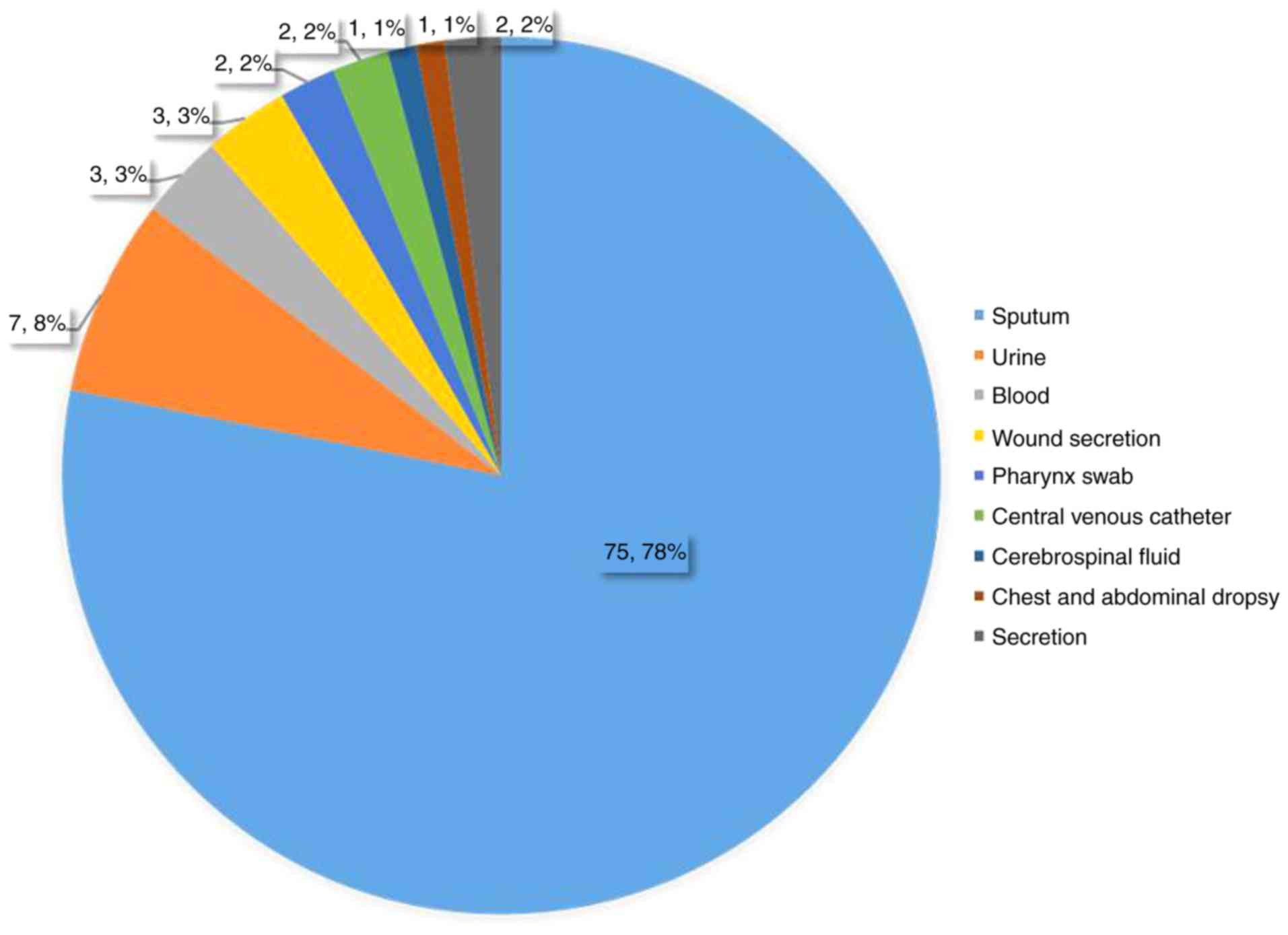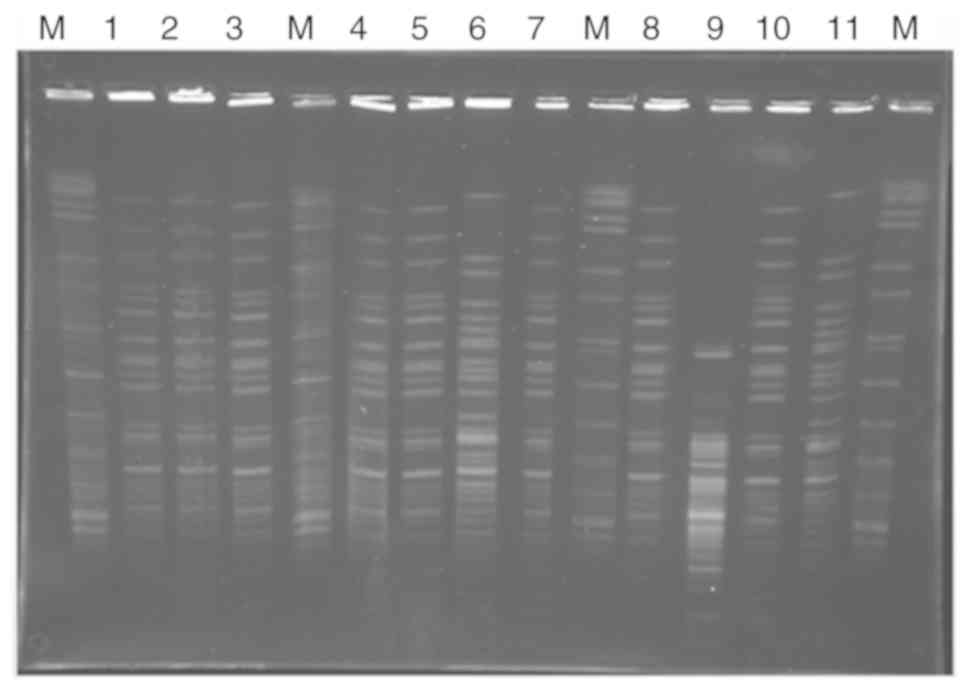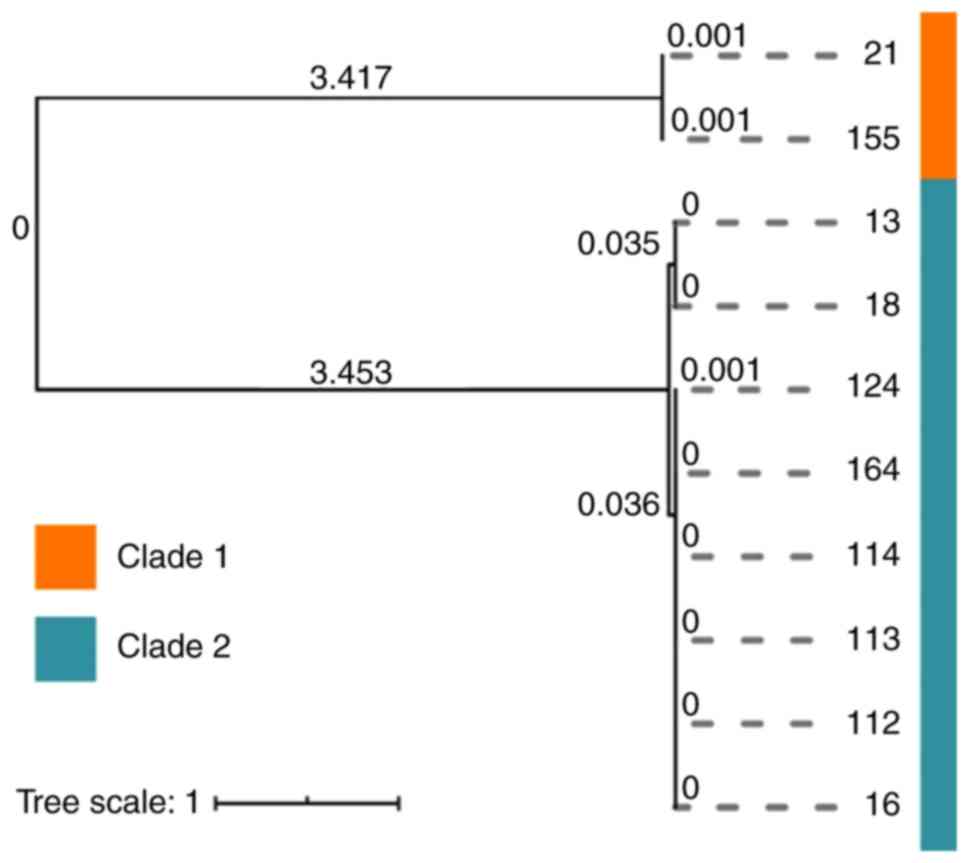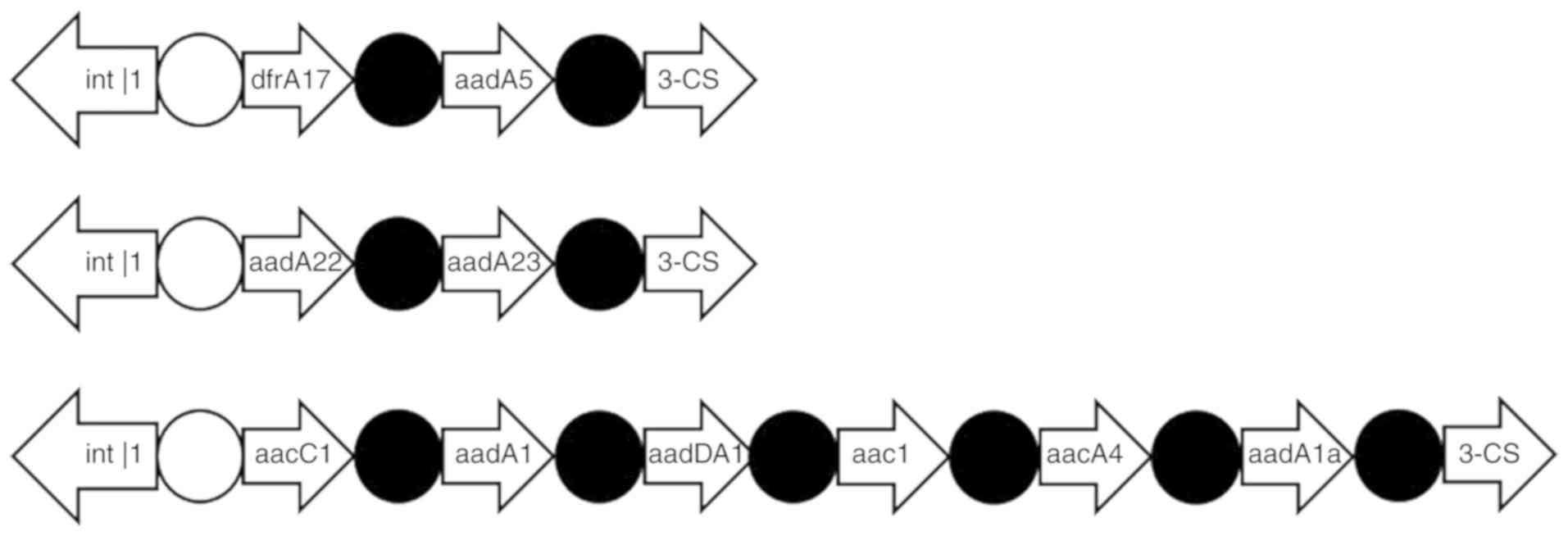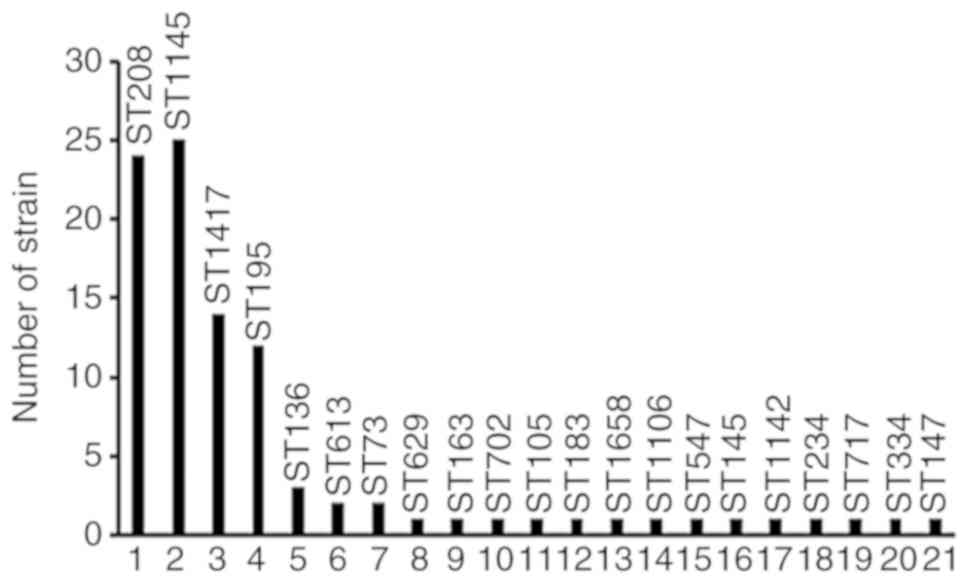|
1
|
Da Silva GJ and Domingues S: Insights on
the horizontal gene transfer of carbapenemase determinants in the
opportunistic pathogen Acinetobacter baumannii.
Microorganisms. 4(E29)2016.PubMed/NCBI View Article : Google Scholar
|
|
2
|
Antunes LC, Visca P and Towner KJ:
Acinetobacter baumannii: Evolution of a global pathogen.
Pathog Dis. 71:292–301. 2014.PubMed/NCBI View Article : Google Scholar
|
|
3
|
Lee CR, Lee JH, Park M, Park KS, Bae IK,
Kim YB, Cha CJ, Jeong BC and Lee SH: Biology of Acinetobacter
baumannii: Pathogenesis, antibiotic resistance mechanisms, and
prospective treatment options. Front Cell Infect Microbiol.
7(55)2017.PubMed/NCBI View Article : Google Scholar
|
|
4
|
Fupin H, Guo Y, Zhu D, et al: CHINET
surveillance of bacterial resistance across China: Report of the
results in 2016. Chin J Infect Chemotherapy. 17:481–491. 2017.(In
Chinese).
|
|
5
|
Hu FP, Guo Y, Zhu DM, Wang F, Jiang XF, Xu
YC, Zhang XJ, Zhang CX, Ji P, Xie Y, et al: Resistance trends among
clinical isolates in China reported from CHINET surveillance of
bacterial resistance, 2005-2014. Clin Microbiol Infec. 22 (Suppl
1)(S9-S14)2016.PubMed/NCBI View Article : Google Scholar
|
|
6
|
Hall RM and Collis CM: Mobile gene
cassettes and integrons: Capture and spread of genes by
site-specific recombination. Mol Microbiol. 15:593–600.
1995.PubMed/NCBI View Article : Google Scholar
|
|
7
|
Mazel D, Dychinco B, Webb VA and Davies J:
A distinctive class of integron in the Vibrio cholerae genome.
Science. 280:605–608. 1998.PubMed/NCBI View Article : Google Scholar
|
|
8
|
Correia M, Boavida F, Grosso F, Salgado
MJ, Lito LM, Cristino JM, Mendo S and Duarte A: Molecular
characterization of a new class 3 integron in Klebsiella
pneumoniae. Antimicrob Agents Chemother. 47:2838–2843.
2003.PubMed/NCBI View Article : Google Scholar
|
|
9
|
Cambray G, Guerout AM and Mazel D:
Integrons. Annu Rev Genet. 44:141–166. 2010.PubMed/NCBI View Article : Google Scholar
|
|
10
|
Martinez-Freijo P, Fluit AC, Schmitz FJ,
Grek VS, Verhoef J and Jones ME: Class I integrons in Gram-negative
isolates from different European hospitals and association with
decreased susceptibility to multiple antibiotic compounds. J
Antimicrob Chemoth. 42:689–696. 1998.PubMed/NCBI View Article : Google Scholar
|
|
11
|
Chen J, Li H, Yang J, Zhan R, Chen A and
Yan Y: Prevalence and characterization of integrons in multidrug
resistant Acinetobacter baumannii in eastern China: A
multiple-hospital study. Int J Environ Res Public Health.
12:10093–10105. 2015.PubMed/NCBI View Article : Google Scholar
|
|
12
|
Machado E, Cantón R, Baquero F, Galán JC,
Rollán A, Peixe L and Coque TM: Integron content of
extended-spectrum-beta-lactamase-producing Escherichia coli strains
over 12 years in a single hospital in Madrid, Spain. Antimicrob
Agents Chemother. 49:1823–1829. 2005.PubMed/NCBI View Article : Google Scholar
|
|
13
|
Urban C, Mariano N, Rahal JJ, Tay E, Ponio
C, Koprivnjak T and Weiss J: Polymyxin B-Resistant Acinetobacter
baumannii Clinical isolate susceptible to recombinant BPI and
cecropin P1. Antimicrob Agents Chemother. 45:994–995.
2001.PubMed/NCBI View Article : Google Scholar
|
|
14
|
Bankevich A, Nurk S, Antipov D, Gurevich
AA, Dvorkin M, Kulikov AS, Lesin VM, Nikolenko SI, Pham S,
Prjibelski AD, et al: SPAdes: A new genome assembly algorithm and
its applications to single-cell sequencing. J Comput Biol.
19:455–477. 2012.PubMed/NCBI View Article : Google Scholar
|
|
15
|
Nurk S, Bankevich A, Antipov D, Gurevich
AA, Korobeynikov A, Lapidus A, Prjibelski AD, Pyshkin A, Sirotkin
A, Sirotkin Y, et al: Assembling single-cell genomes and
mini-metagenomes from chimeric MDA products. J Comput Biol.
20:714–737. 2013.PubMed/NCBI View Article : Google Scholar
|
|
16
|
Treangen TJ, Ondov BD, Koren S and
Phillippy AM: The Harvest suite for rapid core-genome alignment and
visualization of thousands of intraspecific microbial genomes.
Genome Biol. 15(524)2014.PubMed/NCBI View Article : Google Scholar
|
|
17
|
Letunic I and Bork P: Interactive tree of
life (iTOL) v4: Recent updates and new developments. Nucleic Acids
Res. 47(W256-W259)2019.PubMed/NCBI View Article : Google Scholar
|
|
18
|
Chen DQ, Jiang YT, Feng DH, Wen SX, Su DH
and Yang L: Integron mediated bacterial resistance and virulence on
clinical pathogens. Microb Pathog. 114:453–457. 2018. View Article : Google Scholar
|
|
19
|
Rowe-Magnus DA, Guerout AM and Mazel D:
Bacterial resistance evolution by recruitment of super-integron
gene cassettes. Mol Microbiol. 43:1657–1669. 2002.PubMed/NCBI View Article : Google Scholar
|
|
20
|
Goudarzi M and Azimi H: Dissemination of
classes 1, 2, and 3 integrons in Acinetobacter baumannii
strains recovered from intensive care units using polymerase Chain
reaction-restriction fragment length polymorphism. Jundishapur J
Microbiol. 10(e13100)2017.PubMed/NCBI
|
|
21
|
Huang C, Long Q, Qian K, Fu T, Zhang Z,
Liao P and Xie J: Resistance and integron characterization of
Acinetobacter baumannii in a teaching hospital in Chongqing,
China. New Microbes New Infect. 8:103–108. 2015.PubMed/NCBI View Article : Google Scholar
|
|
22
|
Tenover FC, Arbeit RD, Goering RV,
Mickelsen PA, Murray BE, Persing DH and Swaminathan B: Interpreting
chromosomal DNA restriction patterns produced by pulsed-field gel
electrophoresis: Criteria for bacterial strain typing. J Clin
Microbiol. 33:2233–2239. 1995.PubMed/NCBI
|
|
23
|
Maiden MC: Multilocus sequence typing of
bacteria. Annu Rev Microbiol. 60:561–588. 2006.PubMed/NCBI View Article : Google Scholar
|
|
24
|
Miragaia M, Thomas JC, Couto I, Enright MC
and de Lencastre H: Inferring a population structure for
Staphylococcus epidermidis from multilocus sequence typing data. J
Bacteriol. 189:2540–2552. 2007.PubMed/NCBI View Article : Google Scholar
|
|
25
|
González-Escalona N, Martinez-Urtaza J,
Romero J, Espejo RT, Jaykus LA and DePaola A: Determination of
molecular phylogenetics of Vibrio parahaemolyticus strains by
multilocus sequence typing. J Bacteriol. 190:2831–2840.
2008.PubMed/NCBI View Article : Google Scholar
|
|
26
|
Lacher DW, Steinsland H, Blank TE,
Donnenberg MS and Whittam TS: Molecular evolution of typical
enteropathogenic Escherichia coli: Clonal analysis by multilocus
sequence typing and virulence gene allelic profiling. J Bacteriol.
189:342–350. 2007.PubMed/NCBI View Article : Google Scholar
|
|
27
|
Mugnier PD, Poirel L, Naas T and Nordmann
P: Worldwide dissemination of the blaOXA-23 carbapenemase gene of
Acinetobacter baumannii. Emerg Infect Dis. 16:35–40.
2010.PubMed/NCBI View Article : Google Scholar
|
|
28
|
Diancourt L, Passet V, Nemec A, Dijkshoorn
L and Brisse S: The population structure of Acinetobacter
baumannii: Expanding multiresistant clones from an ancestral
susceptible genetic pool. PLoS One. 5(e10034)2010.PubMed/NCBI View Article : Google Scholar
|
|
29
|
Spratt BG, Hanage WP and Feil EJ: The
relative contributions of recombination and point mutation to the
diversification of bacterial clones. Curr Opin Microbiol.
4:602–606. 2001.PubMed/NCBI View Article : Google Scholar
|
|
30
|
Feil EJ, Holmes EC, Bessen DE, Chan MS,
Day NP, Enright MC, Goldstein R, Hood DW, Kalia A, Moore CE, et al:
Recombination within natural populations of pathogenic bacteria:
Short-term empirical estimates and long-term phylogenetic
consequences. Proc Natl Acad Sci USA. 98:182–187. 2001.PubMed/NCBI View Article : Google Scholar
|
|
31
|
Karah N, Sundsfjord A, Towner K and
Samuelsen Ø: Insights into the global molecular epidemiology of
carbapenem non-susceptible clones of Acinetobacter
baumannii. Drug Resist Update. 15:237–247. 2012.PubMed/NCBI View Article : Google Scholar
|
|
32
|
Zhong Q, Xu W, Wu Y and Xu H: Clonal
spread of carbapenem non-susceptible Acinetobacter baumannii
in an intensive care unit in a teaching hospital in China. Ann Lab
Med. 32:413–419. 2012.PubMed/NCBI View Article : Google Scholar
|
|
33
|
Runnegar N, Sidjabat H, Goh HM, Nimmo GR,
Schembri MA and Paterson DL: Molecular epidemiology of
multidrug-resistant Acinetobacter baumannii in a single
institution over a 10-year period. J Clin Microbiol. 48:4051–4056.
2010.PubMed/NCBI View Article : Google Scholar
|
|
34
|
Han L, Jie Q and Han SS: Clinical and
epidemiological characteristics of multidrug-resistant
Acinetobacter baumannii strains. J Xi'an Jiaotong
University. 38:872–877. 2017.PubMed/NCBI(In Chinese).
|
|
35
|
Lin W, Ying Y and Jiabin L: Multilocus
sequence typing of 87 strains of multidrug-resistant
Acinetobacter baumannii. Acta Universitatis Medicinalis
Anhui. 52:1480–1484. 2017.(In Chinese). PubMed/NCBI
|
|
36
|
van Dessel H, Dijkshoorn L, van der
Reijden T, Bakker N, Paauw A, van den Broek P, Verhoef J and Brisse
S: Identification of a new geographically widespread multiresistant
Acinetobacter baumannii clone from European hospitals. Res
Microbiol. 155:105–112. 2004.PubMed/NCBI View Article : Google Scholar
|
|
37
|
Higgins PG, Dammhayn C, Hackel M and
Seifert H: Global spread of carbapenem-resistant Acinetobacter
baumannii. J Antimicrob Chemother. 65:233–238. 2010.PubMed/NCBI View Article : Google Scholar
|
|
38
|
Liu S, Wang Y, Xu J, Li Y, Guo J, Ke Y,
Yuan X, Wang L, Du X, Wang Z, et al: Genome sequence of an
OXA23-producing, carbapenem-resistant Acinetobacter
baumannii strain of sequence type ST75. J Bacteriol.
194:6000–6001. 2012.PubMed/NCBI View Article : Google Scholar
|
|
39
|
He C, Xie Y, Fan H, Kang M, Tao C, Zhang
R, Hu Y, Chen Z and Wang L: Spread of imipenem-resistant
Acinetobacter baumannii of European clone II in Western
China. Int J Antimicrob Agents. 38:257–260. 2011.PubMed/NCBI View Article : Google Scholar
|
|
40
|
He C, Xie Y, Zhang L, Kang M, Tao C, Chen
Z, Lu X, Guo L, Xiao Y, Duo L and Fan H: Increasing imipenem
resistance and dissemination of the ISAba1-associated blaOXA-23
gene among Acinetobacter baumannii isolates in an intensive
care unit. J Med Microbiol. 60:337–341. 2011.PubMed/NCBI View Article : Google Scholar
|
|
41
|
Fu Y, Zhou J, Zhou H, Yang Q, Wei Z, Yu Y
and Li L: Wide dissemination of OXA-23-producing
carbapenem-resistant Acinetobacter baumannii clonal complex
22 in multiple cities of China. J Antimicrob Chemother. 65:644–650.
2010.PubMed/NCBI View Article : Google Scholar
|
|
42
|
Hamouda A, Evans BA, Towner KJ and Amyes
SG: Characterization of epidemiologically unrelated
Acinetobacter baumannii isolates from four continents by use
of multilocus sequence typing, pulsed-field gel electrophoresis,
and sequence-based typing of bla(OXA-51-like) genes. J Clin
Microbiol. 48:2476–2483. 2010.PubMed/NCBI View Article : Google Scholar
|
|
43
|
Woo PC, Tsang AK, Wong AY, Chen H, Chu J,
Lau SK and Yuen KY: Analysis of multilocus sequence typing schemes
for 35 different bacteria revealed that gene loci of 10 bacteria
could be replaced to improve cost-effectiveness. Diagn Microbiol
Infect Dis. 70:316–323. 2011.PubMed/NCBI View Article : Google Scholar
|















